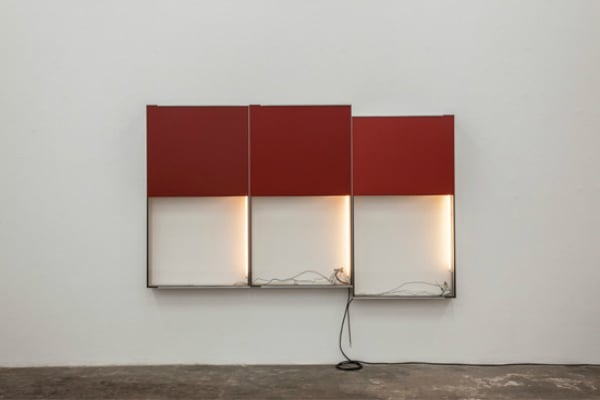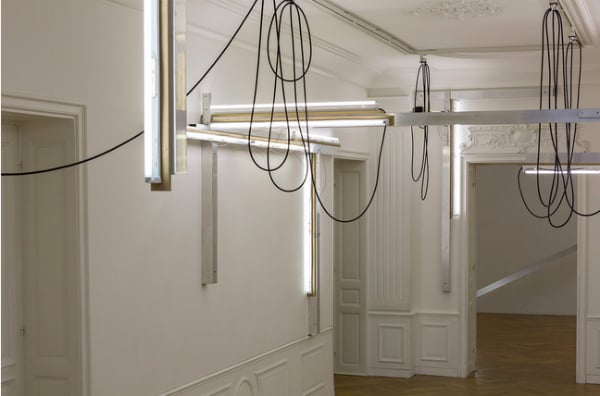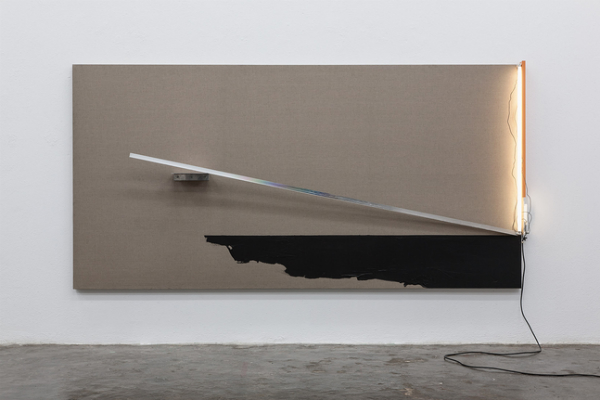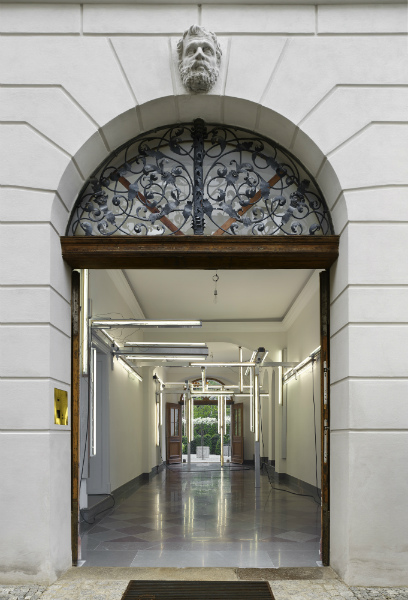Art & Exhibitions
artnet Asks: Pedro Cabrita Reis
He really doesn't want you to call his work "architectural."

He really doesn't want you to call his work "architectural."

Hili Perlson

For his most recent show at Kewenig Galerie in Berlin, Pedro Cabrita Reis installed a meandering aluminum and neon-lit sculpture that snakes up the gallery’s impressive baroque staircase. The piece, titled Les Lieux Fragmentés (2015), with its exposed cables and cold industrial materials, could easily appear harsh against the antique wooden stairway. However, instead of the strictness that its standardized materials may invoke, the immersive installation feels fallible, and even sensual, with the bare elements evincing a layer of candidness that exists in Reis’s oeuvre.
Seven fresh oranges are positioned atop one of the aluminum elements. The artist has instructed gallery staff to eat the oranges and replace them weekly with new fresh ones, as he isn’t at all interested in decay, but rather in inhabiting territories. But whatever you do, don’t call his work “architectural.” Below, Reis explains how to combat boredom when installing a show, how to impose yourself on a space, and why he would never leave Portugal.
A lot of the works in this show were created here in Berlin. Was there something about the city’s constantly being under construction that gave rise to some of these pieces, or even, to the materials used in them?
This exhibition has three layers in its structure. The work Les Lieux Fragmentés (2015) was a commission for one of my last shows, in France. I constructed this work for them that would spread around the space and contaminate the rooms, the staircases, corridors, and so on. After visiting Kewenig Gallery I understood that it would be very interesting to re-install that work here. Obviously, when you re-install, it’s always different, it’s always new, it gains a totally different tension, the relations with the viewers are completely new, and in fact I have to say, it’s better here.
How so?
Because here’s it’s more concentrated. It gains momentum. The staircase plays a very important role, and is very challenging. You do not negotiate with space, you impose yourself in the space. I looked at my work again and felt that it could do more. So this is the first level: a work done for one place and then reanimated here. The second level includes works that come from my studio, regular work that I do every day.
The third level is something that happens all the time: it’s very boring installing an exhibition. You have to do something, otherwise you get crazy. I get nervous. So I went to the gallery storage, which is a lovely building where I hope they’ll open a second gallery very soon, and I found some stuff there that we brought to the show. That was the material base of two works done in situ. We don’t consider them site-specific, they are just done in situ.

Pedro Cabrita Reis, Les Lieux fragmentés (2015).
Photo: Courtesy Kewenig Berlin.
Where did you work on the pieces you created here? Do you have a Berlin studio?
A studio is an ongoing process of thinking. And you can do it in the hotel room, you can do it in the train. I don’t know how many retrospectives I’ve done on trains [laughs]. For some reason, alongside the train tracks there’s always a lot of debris. It’s something which is hidden from the eyes of the city. I always get new ideas for projects when I’m traveling by train.
In one of the rooms there’s a piece made of white aluminum covers which are in fact parts of the lights in the big work. In principle, there is a lamp, there is a cover, so you don’t see the cables. But I don’t hide anything, neither in life nor in my work. So I removed the covers and did what I always do: I recycle shit.
And that piece is now a self-portrait. Can you tell me about that?
I made an autobiographic piece from them, titled, Self-Portrait with Numbers. The numbers go from 1956, when I was born, until 2015. Before 1956 there are a few ones without numbers because the past exists, but there is nothing after 2015 because the future doesn’t exist. 1974 was the revolution, when we got rid of the fascist regime [in Portugal], and all the capitalist bourgeoisie fled to Switzerland, Brazil, etc., and we took over the country for a few years—not many, not enough.
Did you ever consider leaving Portugal?
I would never, ever, under any condition leave. Unless some bomb destroyed the country. But that’s where I want to be. I live near the airport, that’s good enough; traveling, coming back, this back and forth—that’s how you construct the notion of your position. There’s this magnificent book by a Russian man called Vladimir Ilitch Oulianov, popularly known as Lenin. He wrote a book titled One Step Forward, Two Steps Back, which was exactly about the process and the development of the revolutionary process. I like to stay in the place where I walk two steps and then I come back one step.
You know which is the best part of a trip? Coming back. It’s when you come back that you mentally measure the transformation you’ve gone through, everything you have seen and condensed into an experience. You cannot do this when you are just going. You have to come back.

Pedro Cabrita Reis Raw Canvas #8 (2015).
Photo: Courtesy Kewenig Berlin.
That said, I belong to a generation that strongly questioned the issue of a so-called “national identity.” I was born in 1956, and started working immediately after the revolution in 1974, and me and my small group of friends, we were starting up in the 1980s. In those days, we did our best to escape and argue and discuss this concept of national identity. Why? Because this was a quintessential ideological process of the fascists. The fascists always built up this mockery of so-called nation, or patria, based on this subjective feeling of belonging to a place.
But the communists were, at that time, relating to Moscow. So the revisionists also, like the fascists, built a political program where this so-called national identity was important. We were not very happy with that; as artists we were not at all expecting that our work could or should represent or materialize in any way this national identity. I don’t have a national identity. If I did, I share it with Thomas Schütte, with Juan Muñoz, with Miroslaw Balka—that’s my national identity. We witnessed and lived in a revolutionary process, and we also witnessed the decay of a revolutionary moment and the coming back of the conservatives.
Interestingly, right outside the gallery, Berlin is witnessing the architectural eradication of a revolutionary moment turned bad. The traces of the GDR are being replaced by re-enactments of romantic and baroque architecture. Everything is under construction but looking backwards.
Many people tend to look at my work as intimately and directly related to architecture. I, instead, like to consider myself on the side of construction. I have this clear idea that architecture is nothing else than a political form to contain social tensions in the urban context. So what are architects doing in general? They create the city, but the city is created in order that the class struggle is contained. That’s what architecture does—confine people so that social tensions seem smooth and regulated.
My work is not part of that problem. This is the problem of sociology, politics, and ideology. My work is centered on the problem of construction, and construction itself is a place where we could congregate philosophy and poetry with anthropology. It’s a territory for the individual, while architecture is a territory for the collective. In that sense, I like to consider that what I do is putting two stones together; that I pick up something that someone left on the side of the road and then make something out of it. I reconstruct a mental reference to reality, when you can be aware of your trajectory in the world.

Pedro Cabrita Reis Les Lieux Fragmentés (Berlin) (2015).
Photo: ©Stefan Müller Courtesy Kewenig Berlin.
Which goes back to how you expose the process, or in this case, show all the cables.
That’s right. But this is a battle that I have lost. I can talk to you, I can give lectures, workshops, seminars, and propose this perspective that this is not about architecture, this is about construction. But nobody cares, I’m talking in the desert. I have a show in The Arts Club of Chicago right now. The director sent me three very nice reviews of the show, but all three referred to my work as architecture. What can I do? I can write a memoir, and the title would be Ceci n’est pas architecture.
Pedro Cabrita Reis is on view at Kewenig Galerie, Berlin from May 1–July 31.